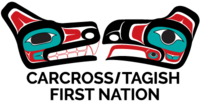
Yukon is the smallest and westernmost of Canada's three territories. It is the most densely populated territory in Canada, with an estimated population of 46,704 as of 2024, though it has a smaller population than all provinces. Whitehorse, the territorial capital, is the largest settlement in any of the three territories.

The Klondike Gold Rush was a migration by an estimated 100,000 prospectors to the Klondike region of Yukon, in north-western Canada, between 1896 and 1899. Gold was discovered there by local miners on August 16, 1896; when news reached Seattle and San Francisco the following year, it triggered a stampede of prospectors. Some became wealthy, but the majority went in vain. It has been immortalized in films, literature, and photographs.
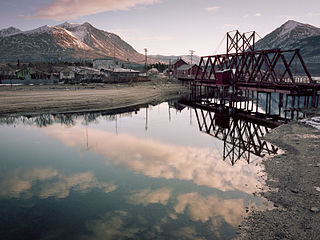
Carcross, originally known as Caribou Crossing, is an unincorporated community in Yukon, Canada, on Bennett Lake and Nares Lake. It is home to the Carcross/Tagish First Nation.
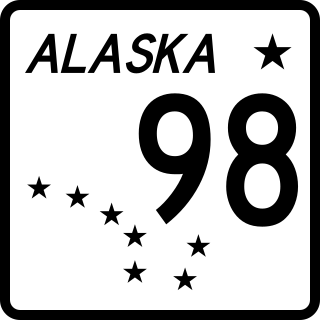
The Klondike Highway is a highway that runs from the Alaska Panhandle through the province of British Columbia and the territory of Yukon in Canada, linking the coastal town of Skagway, Alaska, to Dawson City, Yukon. Its route somewhat parallels the route used by prospectors in the 1898 Klondike Gold Rush.
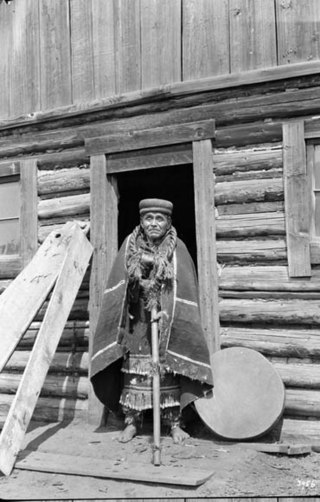
The Tagish or Tagish Khwáan are a First Nations people of the Athabaskan-speaking ethnolinguistic group that lived around Tagish Lake and Marsh Lake, in Yukon of Canada. The Tagish intermarried heavily with Tlingit from the coast and the Tagish language became extinct in 2008. Today Tagish people live mainly in Carcross or Whitehorse and are members of the Carcross/Tagish First Nation or the Kwanlin Dün First Nation.
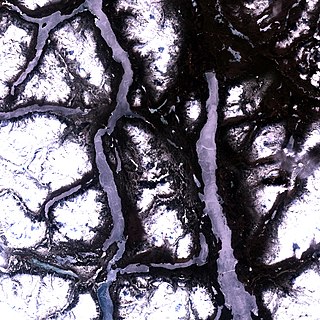
Tagish Lake is a lake in Yukon and northern British Columbia, Canada. The lake is 119 kilometres (74 mi) long and averages 3.2 km (2 mi) wide with an area of 354.48 km2 (136.87 sq mi), about two thirds of which is in British Columbia. The average depth is 62 m (203 ft) and maximum depth is 307 m (1,007 ft).

Carmacks is a village in Yukon, Canada, on the Yukon River along the Klondike Highway, and at the west end of the Robert Campbell Highway from Watson Lake. The population is 588, an increase from the Census of 2016. It is the home of the Little Salmon/Carmacks First Nation, a Northern Tutchone-speaking people.

Keish, also known as James Mason and by the nickname Skookum Jim Mason, was a member of the Tagish First Nation in what became the Yukon Territory of Canada. He was born near Bennett Lake, on what is now the Yukon–British Columbia border. He lived in Caribou Crossing, now Carcross, Yukon.

Shaaw Tláa, also known as Kate Carmack, was a Tagish First Nation woman who was one of the party that first found gold in the Klondike River in 1896, and is sometimes credited with being the person who made the actual discovery.
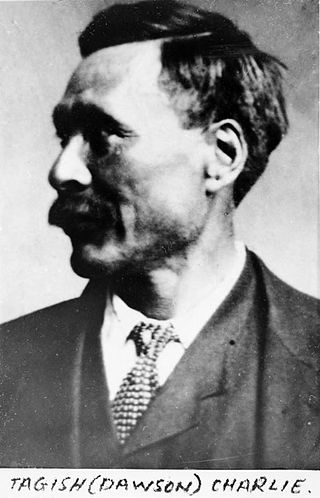
Dawson Charlie or K̲áa Goox̱ [qʰáː kuːχ] was a Canadian Tagish/Tlingit First Nation prospector and one of the co-discoverers of gold at Discovery Claim that led to the Klondike Gold Rush located in the Yukon territory of Northwest Canada. He was the nephew of Keish, also known as Skookum Jim Mason, and accompanied him on his search for his aunt, Kate Carmack. He staked one of the first three claims in the Klondike, along with his uncle and George Carmack. Storyteller Angela Sidney was a niece.
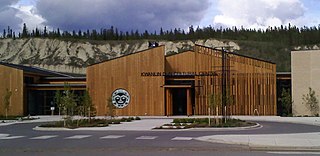
The Kwanlin Dün First Nation (KDFN) or Kwänlin Dän kwächʼǟn is located in and around Whitehorse in Yukon, Canada.
The Yukon Land Claims refer to the process of negotiating and settling Indigenous land claim agreements in Yukon, Canada between First Nations and the federal government. Based on historic occupancy and use, the First Nations claim basic rights to all the lands.
Tagish is an extinct language spoken by the Tagish or Carcross-Tagish, a First Nations people that historically lived in the Northwest Territories and Yukon in Canada. The name Tagish derives from /ta:gizi dene/, or "Tagish people", which is how they refer to themselves, where /ta:gizi/ is a place name meaning "it is breaking up.

George Washington Carmack was an American prospector in the Yukon. He was originally credited with registering Discovery Claim, the discovery of gold that set off the Klondike Gold Rush on August 16, 1896. Today, historians usually give the credit to his Tagish brother-in-law, Skookum Jim Mason.
Angela Sidney, was a Tagish storyteller. She co-authored two narratives of traditional Tagish legends and a historical document of Tagish place names for southern Yukon. For her linguistics and ethnography contributions, Sidney received the Order of Canada, becoming the first Native woman from the Yukon to be so honoured.
"Well, I have no money to leave for my grandchildren. My stories are my wealth!"

Jim Boss was an entrepreneur and the chief of the Southern Tutchone Ta’an Kwäch’än for over 40 years. He is most known for having initiated the first Yukon land claim, in 1902. His leadership allowed the First Nations from the southern region of the Yukon to make the transition from a traditional way of life to a Euro-Canadian economy. In 2001, he was designated a Person of National Historic Significance.

Discovery Claim is a mining claim at Bonanza Creek, a watercourse in the Yukon, Canada. It is the site where, in the afternoon of August 16, 1896, the first piece of gold was found in the Yukon by prospectors. The site is considered to be the place where the Klondike gold rush started. It is located around 17 kilometres (11 mi) south-southeast of Dawson City. The Discovery claim was designated a National Historic Site of Canada on July 13, 1998.

The Indigenous peoples of Yukon are ethnic groups who, prior to European contact, occupied the former countries now collectively known as Yukon. While most First Nations in the Canadian territory are a part of the wider Dene Nation, there are Tlingit and Métis nations that blend into the wider spectrum of indigeneity across Canada. Traditionally hunter-gatherers, indigenous peoples and their associated nations retain close connections to the land, the rivers and the seasons of their respective countries or homelands. Their histories are recorded and passed down the generations through oral traditions. European contact and invasion brought many changes to the native cultures of Yukon including land loss and non-traditional governance and education. However, indigenous people in Yukon continue to foster their connections with the land in seasonal wage labour such as fishing and trapping. Today, indigenous groups aim to maintain and develop indigenous languages, traditional or culturally-appropriate forms of education, cultures, spiritualities and indigenous rights.
